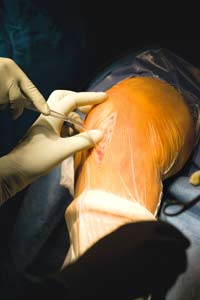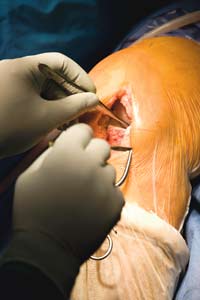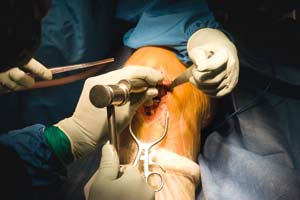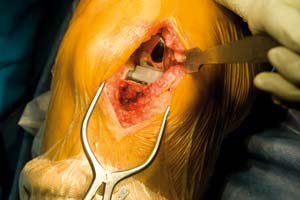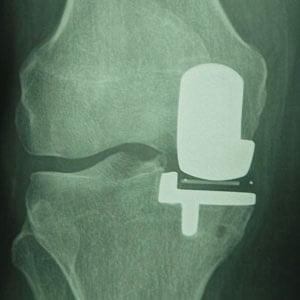
Surgeons have a number of good reasons for increasingly recommending a partial – rather than a total – knee replacement for arthritic joint pain.
It's a less drastic solution to a painful problem; it takes less time for the patient to regain mobility and less bone is removed, which is to the patient's advantage in the long term.
"The aim is to repair only the damage without replacing the whole knee," says Dr Rudolf Oosthuizen, a Johannesburg orthopaedic surgeon and knee-surgery expert.
During a partial (or unicompartmental as it's called) knee replacement, the surgeon doesn't have to remove large sections of bone above and below the kneecap or remove the cruciate ligaments as he would during a total knee replacement.
Only the insides of the top and bottom sections of the bones are removed, which means normal knee function is preserved and the patient can start using the knee sooner.
In addition, research shows partially replaced knees have, on average, up to 120 degrees of flexibility, compared to the 103 degrees of knees that have been totally replaced.
Partial knee replacements have been performed for over 30 years and have proved as successful as total replacements in the long term. In fact, you'll be able to use your knee for 20 years.
You can still have a total replacement later
Another advantage of the less invasive operation is that enough bone is preserved for a total replacement should that become necessary – after which your knee will be fine for a further 20 years.
But should you require a new knee after a total replacement, bone removal and added prosthesis implantation means you'll lose even more bone and this makes for a poorer long-term prognosis.
Unfortunately not everyone is a suitable candidate for this inventive procedure: for example, a total replacement remains the best option for chronic arthritis sufferers.
Nevertheless, for the 30% of patients who do qualify for a partial knee replacement, the results are excellent.
Oosthuizen says this bone-saving operation is set to become increasingly important in cases where the rest of the knee is still intact.
"By preserving bone in the knee, you're ensuring greater flexibility, longer-than-normal use of the knee and therefore a better quality of life for the patient."
Read: How an MRI can show early signs of knee arthritis
What can go wrong?
"It's important to remember the complications arising from a partial knee replacement can be just as serious as those from a total replacement although they're usually much less so," Oosthuizen says.
- The chance of infection – 0,6% – is the same for both procedures.
- Thrombosis of the leg can occur.
- Problems can develop with the prosthesis:
The component (section) cemented to the bone can become loose.
Dislocation (movement) of the polyethylene ball bearing can occur. - A tibial crack (in the lower part of the leg) could occur during or after the procedure.
- Other knee components (the outside section and the patella joint) can erode during normal deterioration as a result of age.
- Pain without a specific, identifiable cause can occur as a result of both partial and total replacements.
PARTIAL KNEE REPLACEMENT OPERATION
Surgery Room 3, Wilgeheuwel Hospital, Roodepoort.
Within just 40 minutes a woman who’d had difficulty walking, was fitted with half an artificial knee. The prosthesis to replace the inside half of her knee joint consisted of three parts: two cobalt-chrome metal pieces and a plastic ball bearing.
14:16 The incision runs lengthways across the knee without damaging the kneecap (patella). The surgeon is seated in front of the bent right knee for easy access
14:20 The worn cartilage at the bottom part of the upper leg and the top part of the lower leg is removed.
14:28 Now the “serious” tools and instruments such as a surgical drill, hammer and tongs are used to chip, chisel and shape the bone. To hold the ball bearing a hole is drilled into the part of the knee made up of the lower section of the upper leg.
14:37 After the surgeon has made precise measurements the ball bearing is fitted into the newly created hole.
14:45 The two metal prostheses are in place: a curved metal piece which clips onto the ball bearing on top, and a flat metal disk on the lower leg. This allows for fluent movement of the metal ball across the flat surface of the lower prosthesis. A plastic disc on top of the lower prosthesis acts as a buffer between the two metal pieces.
14:54 A single cut, perfectly stapled together, is the only visible evidence of the operation.
This woman’s knee will be more flexible after the partial replacement than it would’ve been if her knee had been totally replaced and her patella and the main ligaments of her knee joint are still intact.
Within 24 hours she was up and about.
Read more:
George W Bush has partial knee replacement
Drug-free relief from knee pain
Source: Dr CR Oosthuizen, http://partialkneeacademia.co.za, Wilgeheuwel Hospital, Roodepoort, South Africa.




 Publications
Publications
 Partners
Partners




